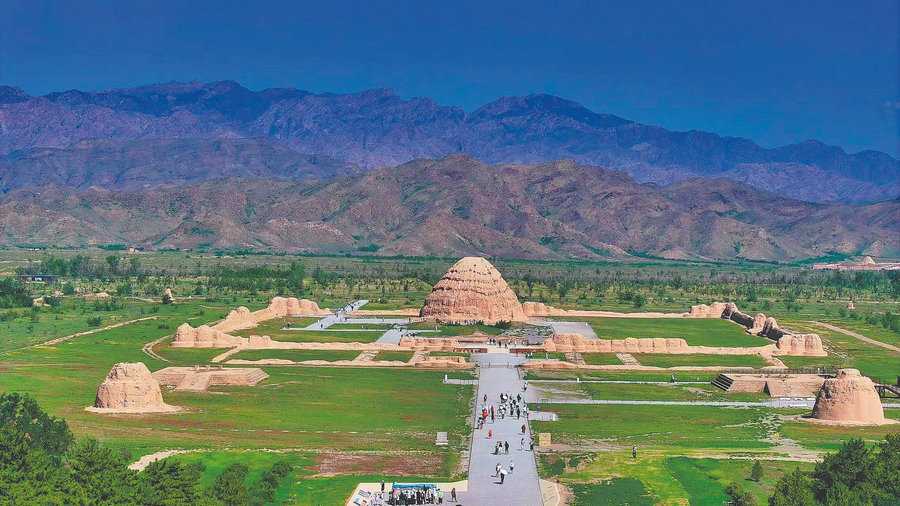In 1227, this dynasty in Northwest China was finally defeated by the Mongol army after a prolonged and valiant resistance — a campaign led by Genghis Khan, who died in his frontline camp during the final assault. Xixia (or Western Xia, 1038-1227), a power lasting for 190 years and once spread across over 1.15 million square kilometers at its zenith, eventually fell in the Gobi Desert.
A panorama of Mausoleums No 1 (front) and No 2 of the Xixia Imperial Tombs, set against the majestic backdrop of the Helan Mountains. [Photo by Jiang Dong/China Daily]
Established by Tangut people and inhabited by various ethnic groups, Xixia was not documented in a specific history book by its successors while most Chinese dynasties were.
However, on the foot of the lingering Helan Mountains, a group of earthen mounds, which marked the long resting places of Xixia rulers, seal an exceptional saga, not only as a footnote on how a united Chinese nation evolved and boomed, but also about a neglected legend on the Silk Road.
The spotlight returns onto this site on the outskirts of Yinchuan, capital of Ningxia Hui autonomous region. On Friday, Xixia Imperial Tombs achieved World Heritage site status during the ongoing 47th Session of the World Heritage Committee of UNESCO in Paris.
Floodwaters gushing from the mountains etched a fan-shaped land, dotted by desert vegetation and bathed in Gobi wilderness.
Within the 3,899 hectares of property zone, its key elements included nine imperial mausoleums, 271 subordinate tombs, 32 flood control work sites, and a 5.03-hectare architectural complex site to the north, whose nature remains subject to debate but most scholars agree that it was used for rituals.
"The combination of artificial and natural elements creates a unique and majestic landscape at the tombs," says Chen Tongbin, honorary director of the Institute of Architectural History, affiliated to the China Architecture Design and Research Group.
Chen is a main drafter of the bidding document seeking World Heritage site status. Visiting the site numerous times, she is still amazed at the breathtaking sunset vista that unrolls in front of her eyes.
"It's hard to grow crops on the landscape of proluvial fan," she explains. "The land is not suitable for massive construction. The site has thus not been much disturbed other than through natural erosion. Its integrity leaves us with a credible source to know history."





 Share:
Share: 







 京公网安备
11010802027341号
京公网安备
11010802027341号